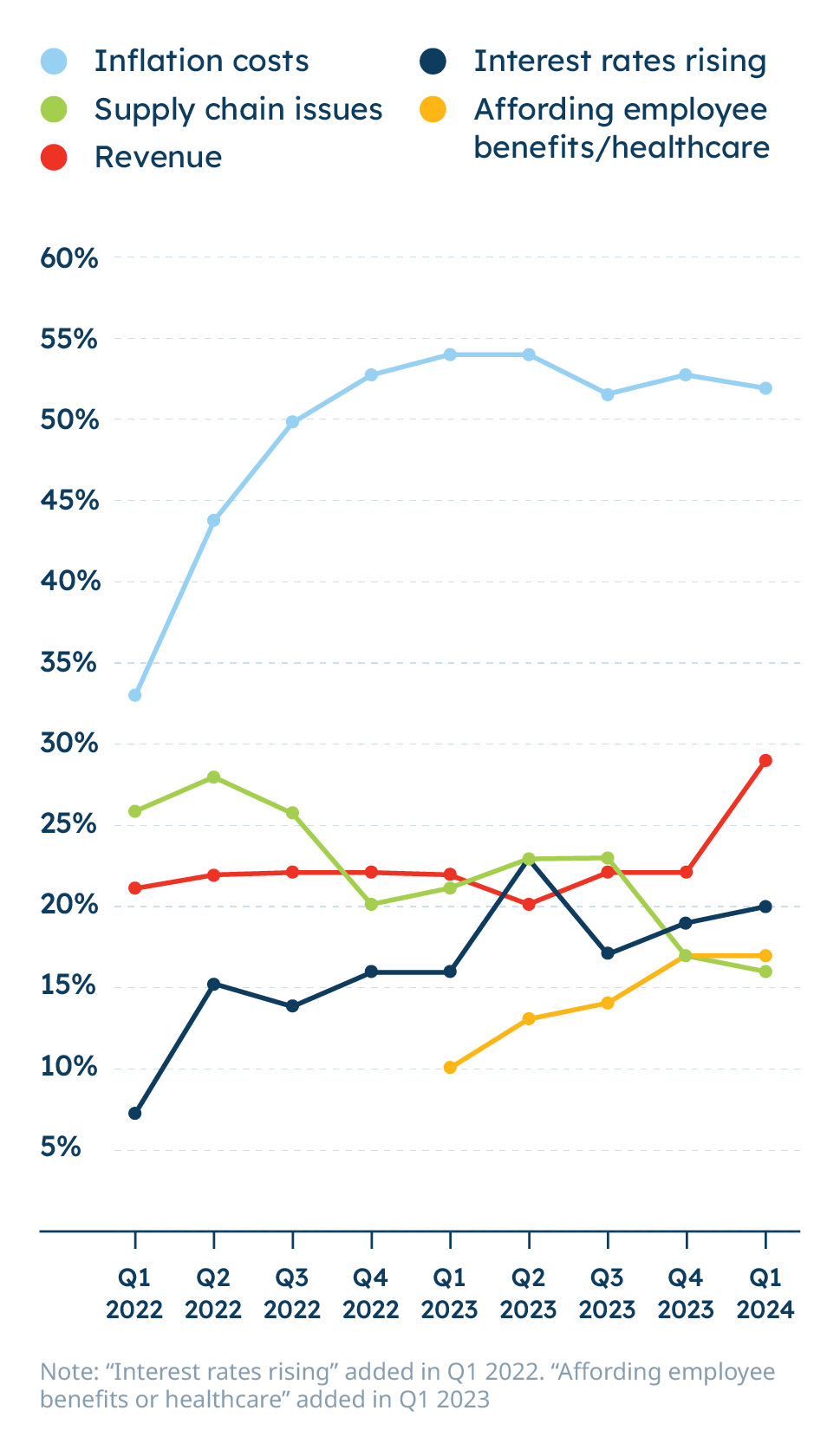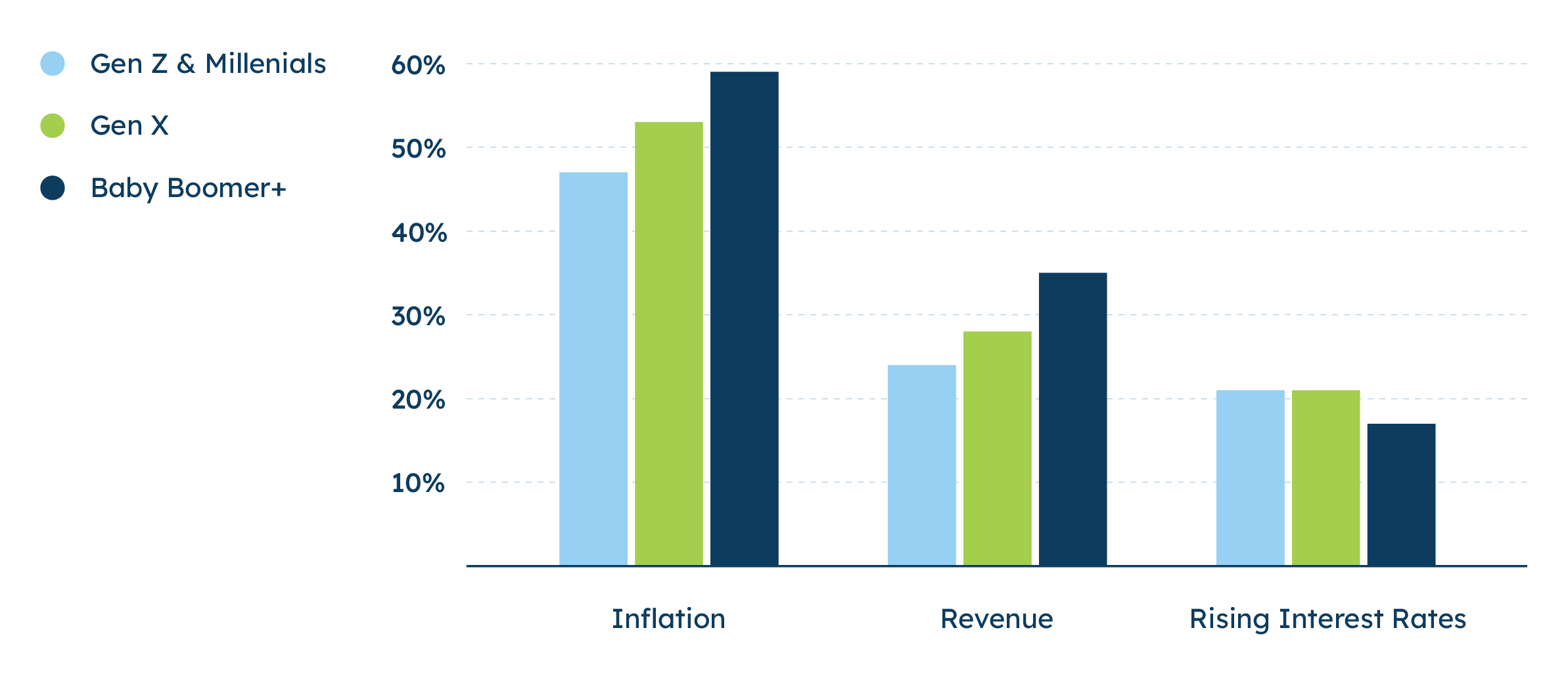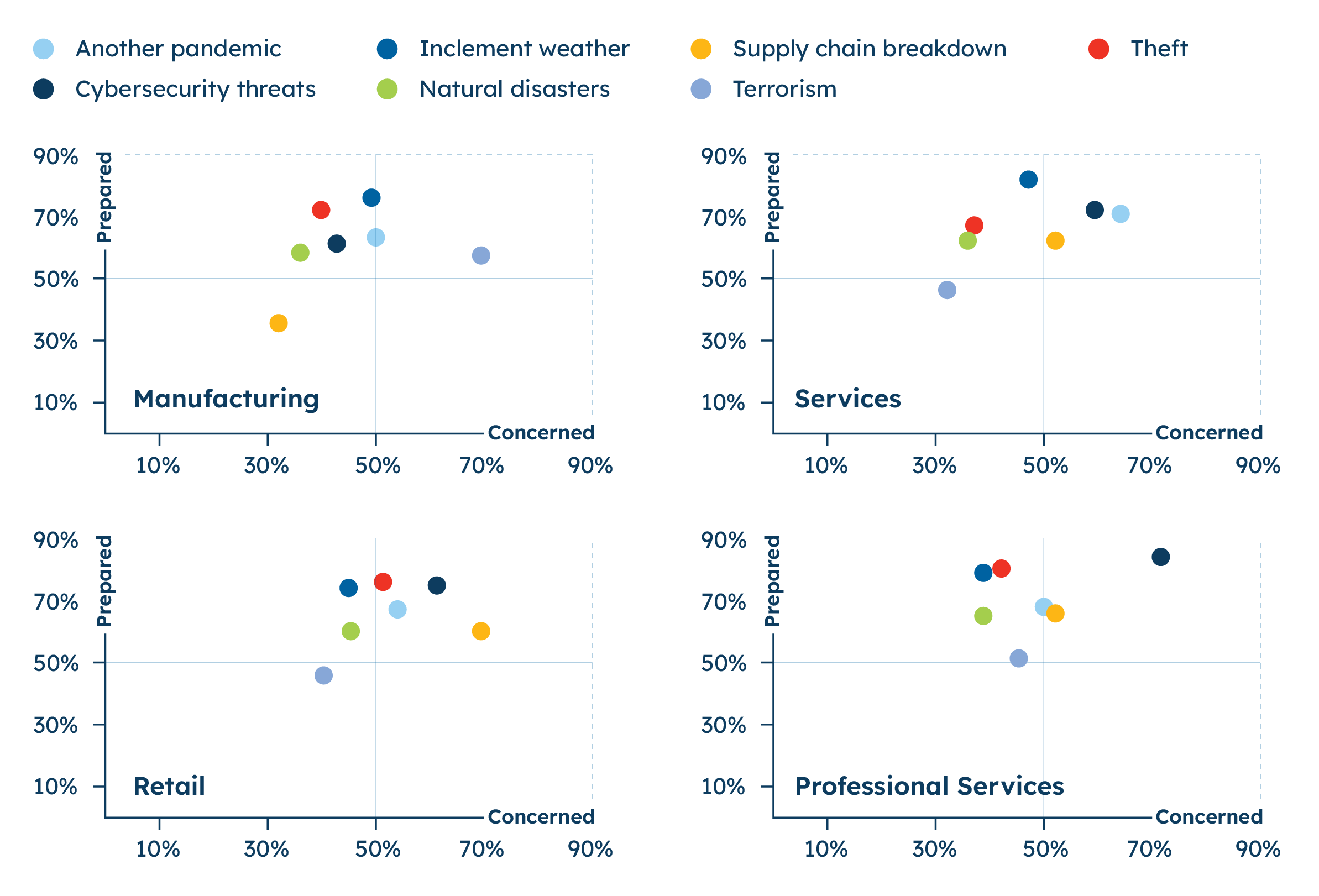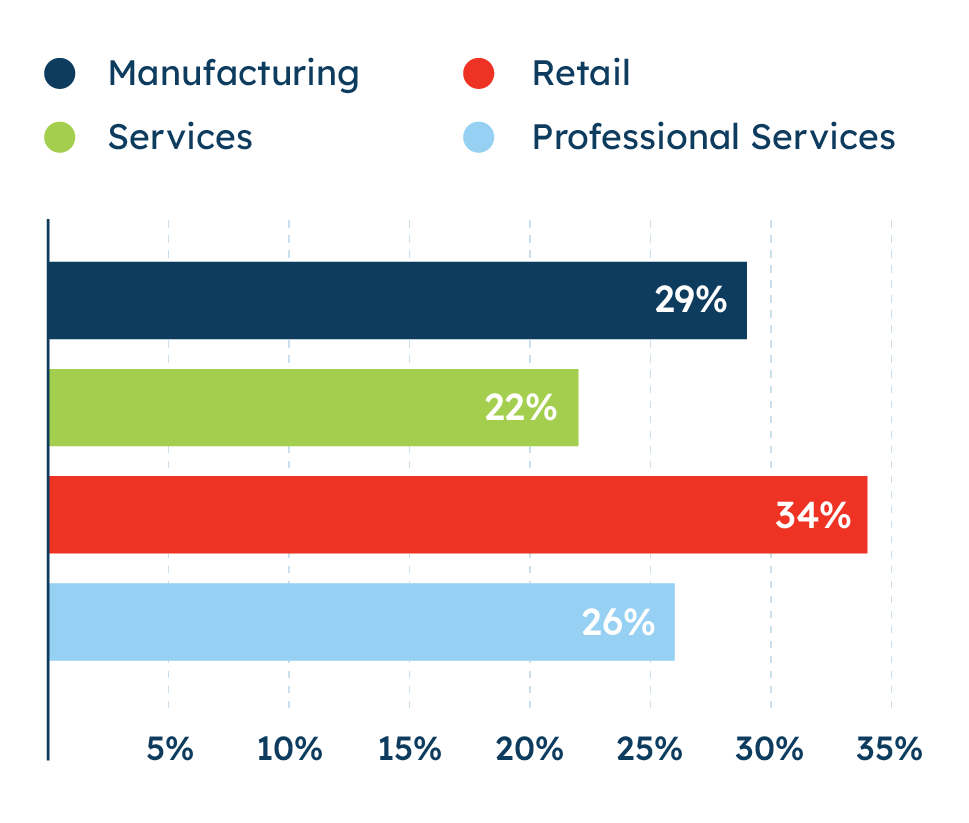Inflation Concerns Remain Stubbornly High

Worries about revenue generation grow
However, small businesses in the professional services sector are least likely of any sector to say inflation costs are their biggest problem (37% vs. 54-61% for other sectors, respectively). This difference not only mirrors findings in Q3 2023, but also marks a shift from last quarter when small businesses in the professional services and manufacturing sectors were less likely to cite inflation as a problem compared to those in the services industry.
Other concerns don’t come close to inflation, but revenue worries, in particular, crept up this quarter. Small businesses are now more likely to say that revenue is their biggest challenge (29% now vs. 22% last quarter). This change brings concerns around revenue back to levels last seen in late 2021. At that time, though, revenue outpaced inflation as a key concern among small businesses.
The smallest small businesses, women-owned, and those owned by baby boomers or older have higher concern about revenue compared to their counterparts. These differences, aside from those by generation of owner, are consistent with Q4 2023. Compared to last quarter, slightly more small businesses owned by baby boomers or older generations say revenue is their biggest challenge (35% vs. 24% in Q4 2023).
Concerns around rising interest rates are stable from last quarter, with 20% of small businesses citing rising rates as a top concern this quarter.
Top 5 biggest challenges facing small business owners

Biggest challenge right now by generation of owner (% selecting, top 3 shown)

Alpharetta, Georgia
Cybersecurity, supply chain disruptions are biggest concerns
A majority (60%) of small businesses say cybersecurity threats (phishing, malware, ransomware) are a top concern. A majority also say that supply chain breakdowns (58%) and another pandemic occurring in the future (54%) are top concerns. Less than half of small businesses say they are concerned about inclement weather (45%), theft (42%), natural disasters (39%), or an act of terrorism (37%).
Past experience with the COVID-19 pandemic may be increasing small businesses’ confidence that they can handle any new pandemic that emerges. A majority of small businesses say they are more prepared to handle a pandemic than they were before COVID-19 (83%). Most small businesses also say they are adequately prepared for future threats (71%).
Four in five (80%) small businesses say they have a clear idea of how to change their business if it starts to struggle, levels that are up 13 percentage points from Q4 2020 (67%), but six points under Q2 2018 levels (86%). Additionally, compared to 2018, small businesses are much less likely to strongly agree (24% in Q1 2024, 52% in Q2 2018) that they have a clear idea of how they would need to change their business if it started to struggle.

Concern vs. preparedness
Concern about a possible future disaster is not the same as being prepared for one. A business could be more concerned about a type of disaster (say, supply chain disruption), but also feel well prepared for it (an emergency plan is in place, there are other suppliers, etc.). On the other hand, it could be less concerned and feel well prepared (say, for natural disaster).
This quarter’s survey reveals some interesting trends about small businesses concerns and perceived preparation for various disasters. For example, the small businesses most concerned about cybersecurity threats include businesses with 20-500 employees (74%) and businesses in the professional services industry (71%). On the other hand, small businesses that are least likely to say they are prepared for cyber threats include businesses in the manufacturing sector (61%), female-owned businesses (68%), and businesses in average health (64%).
Turning to other threats, three in four small businesses say they are prepared to handle inclement weather (77%), theft (74%), or cybersecurity threats (73%). Fewer, but still a majority, say they are prepared to handle another pandemic (67%), natural disasters (61%), or a supply chain breakdown (61%).
Though these topline numbers indicate most small businesses feel prepared to handle what comes their way, across the board, most say they are only somewhat prepared to deal with them, rather than very prepared. Take cybersecurity threats, for example: 23% are very prepared, versus 50% who feel somewhat prepared. The gap is even larger in preparedness for a supply chain breakdown (14% very prepared, 47% somewhat prepared).
The most significant differences in small business concern and preparedness for crises arise when differentiated by sector. For example, small businesses in professional services feel significantly more concerned about cybersecurity threats than those in manufacturing or services, but also feel more prepared than those in manufacturing or services to handle them.
In contrast, small businesses in the manufacturing and retail industries feel most concerned about a supply chain breakdown, though only about three in five feel prepared to handle one if it occurs. Another pandemic is the most concerning threat to businesses in the services industry, though most feel prepared to handle it.
Small business concern & preparedness for various disasters (by sector)

Niles, Illinois
One crisis away from shutting down
One in four (27%) small businesses say they are one disaster or threat away from shutting down. This is especially true for businesses owned by Gen Zers or millennials (34%) and businesses in operation for 10 years or less (33%). By sector, retailers (34%) are more likely to say they’re one disaster from shutting down than the services sector where only 22% say the same.
The threat of cybersecurity threats, supply chain breakdowns, and another pandemic are clearly top-of-mind for these small businesses. Yet this data shows there is still room for growth when it comes to small businesses feeling adequately prepared—and feeling confident about their own level of preparedness—for whatever lies ahead
Percentage that said their business is one disaster or threat away from shutting down (by sector)


How small businesses are preparing for future threats
Small businesses are turning to training staff, finding new suppliers, building up rainy-day funds, and other measures to address a range of potential threats.
For example, roughly half of small businesses say they have trained staff on cybersecurity measures (48%) in the past year, levels that are highest among the professional services industry (64%) and among businesses with between 20-500 employees (69%). Small businesses that say they are ahead of the pack when it comes to technology are also far more likely to say they have trained employees on cybersecurity threats (72%).
To counter supply chains threats, one in three (35%) small businesses report building out their supply chain in the last year. Among the businesses that have built out existing supply chains in the past year, the most popular measures include strengthening relationships with suppliers (53%) or seeking out additional suppliers (48%). Fewer say they have used technology to streamline their supply chain (32%) or used demand planning or forecasting to optimize inventory on-hand (25%).
Small businesses that report taking the following measures in the past year (% yes)

Small businesses have also bolstered their rainy-day funds over the past year: Roughly three in five small businesses report contributing to (62%) or establishing (62%) a rainy-day fund to prepare for a crisis or future threat.
A majority of small businesses (61%) also feel comfortable that said rainy-day fund would be able to help with the unexpected. This represents an eight-point increase since 2018, when 53% of businesses felt comfortable with their rainy-day fund. When asked about comfort with their rainy-day fund, just 10% of small businesses indicated they didn’t have one in 2024, compared to 33% in 2018.
However, small businesses with 1-4 employees are less likely to have a rainy-day fund (87% have a rainy-day fund) than small businesses with 5-19 (94%) or 20-500 employees (96%). They also feel less comfortable that their rainy-day funds would help with the unexpected (55% of businesses with 1-4 employees are comfortable vs. 65% of those with 5-19 employees and 80% of those with 20-500 employees).
Small businesses are planning for worst-case scenarios in a number of other ways as well. A minority (around two in five) of small businesses say they have established a formalized plan for future threats (43%) or taken out insurance in case of natural disasters (38%). Less than one in three say they have established a risk management team (30%) or taken out business interruption insurance (22%).
Larger small businesses are far more likely to report establishing a risk management team in the past year: 55% of small businesses with 20-500 employees report doing so compared to 25% with 5-19 employees or 27% of businesses with 1-4 employees.
Tulsa, Oklahoma

